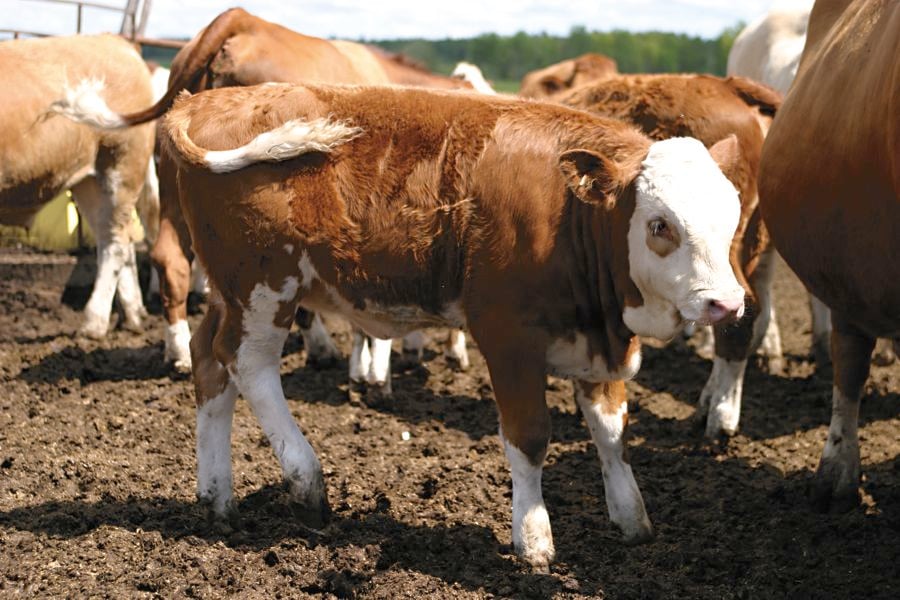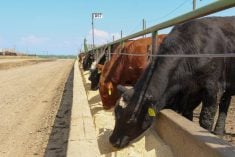Over the past year we’ve had unparalleled high prices in the beef industry, but with the last few months representing one of the largest price declines in the history of the industry. Yet prices are still relatively profitable for the cow-calf industry.
Not so for cattle feeders, who have just undergone a period of historic losses. Thankfully (I think) the fall of the Canadian dollar has buffered the Canadian feeding industry from some of the full impact of this price inversion.
Most of us on the cow-calf side of the business sell cattle by the pound. The more pounds we sell, the bigger the cheque we receive, but when we look at the context of the whole industry it becomes readily apparent that not all pounds are created equal. This creates the potential to capture premiums or risk discounts.
Read Also

Harvest wraps up and fall work begins
At the Eppich famly ranch in western Saskatchewan, the fall harvest was successful with few breakdowns, cows and calves have been sorted and a new tractor has arrived
Feedlots buying cattle typically have pretty solid risk management programs in place and they are usually acutely aware of their break even and how much they can afford to pay for cattle. Capturing extra dollars really boils down to making your pounds more valuable than the average pounds. So the first question is how we accomplish this feat?
Load and pen lots
Many producers may not realize the premiums available from being able to sell truckloads or pen loads of cattle. A truckload is roughly 60,000 pounds, and a pen load in a modern lot may range from 150 to over 600 head. The ability to fill trucks or pens completely may seem like small potatoes, but consider the savings. Let’s take a $1,000 truck trip divided against a truck that is 3/4 full of 600-pound calves. Instead of 100 calves there are 75 head. That works out to an added cost of $3.33 per head. That seems pretty small until you consider it across an entire feedlot. If you have this added cost in a small lot of 5,000 head, that equates to $16,650.
Consider the logistics of filling a large pen over a short time frame and getting cattle onto a uniform feeding program versus filling the same pen over two or three weeks. That can have a huge impact on cost of gain.
This is part of the appeal of pre-sort sales, but also why larger groups of calves will tend to receive a price premium.
Uniformity
This relates to load and pen lots, but deserves separate consideration. On any given day at a market there is potentially huge differences in cattle in the same weight range. If we fall back on our 600-pound weaned calf example, the most basic difference could be weeks to months of difference in age of the cattle. A calf that takes eight months to reach 600 pounds is significantly different than one that accomplishes the same feat in six months. It is highly likely the feeding characteristics of these cattle are also significantly different. For this reason alone it may be worth seeking out like-minded programs used by other producers whom which you can co-market cattle. There is a premium for uniform cattle for a variety of reasons including ease of management and the ability to feed to their expected potential.
Health
Most cow herds have a reasonable health program. Taking some extra steps to ensure the health of cattle marketed is often as simple as providing a booster shot prior to weaning. This should take place two weeks to a month prior to weaning/shipping so that the calf can build some immunity. It is likely the calf will receive similar shots upon initiation to the feedlot, but the investment of a few dollars at the cow-calf end can result in a reduced death or chronic count, particularly during that first stressful month in the feedlot. Healthy calves are worth more and feeders certainly remember losses.
Genetics
As mentioned previously, not all cattle are created equal. As well, every management system is unique and requires something a bit unique to fit the bill. For most of us, fertility is much more important than growth or carcass characteristics. That said, there are some basics we should consider. Some cattle are not well suited to go onto full feed post-weaning, and should not be marketed that way. Additionally, some calves are not well suited for backgrounding and have the genetic makeup to handle a bit of a push. Separating the offering of these basic genetically different packages can go a long way toward improving performance and price.
As well, some base level of post-weaning performance, feed efficiency and carcass merit should be considered when looking at sire purchases, even if you are not retaining ownership of your calves past weaning. Profit has to come from somewhere and if cattle do not have the basic characteristics to perform in the marketplace, the profit will be made in the purchase price. It is easier than ever to obtain some of this knowledge with new technology such as BIXS that can provide feedback from further down the chain.
Talk about it
Good communication is one of the weaknesses that many of us share. We can’t get angry when we take all the right steps and still receive average price for our calves if we failed to tell anybody about the steps we take. It is OK to talk to buyers about your cattle, or prepare information sheets.
We’ve been fortunate over the years to work with markets and buyers who will allow and even encourage us to provide information on our cattle and our program. This not only helps to tell a positive story of why your cattle are not average, but also provides a tremendous risk reduction for the buyer. Knowing that calves are vaccinated may allow them to factor in a lower death loss, or understanding the type of sires used may allow them to price in a feed efficiency or carcass grid premium into the price paid for weaned calves.
Accountability and thankfulness
Accountability probably should go without saying, but it should be mentioned. When we take steps to add value to our cattle and market that added value it is extremely important to “put your money where your mouth is” so to speak. Misrepresentation will always come back to bite you.
Being thankful is also something that should probably go without saying as well. Obviously being thankful for a sale/purchase happens post-sale when the price is already established, but an attitude of gratitude goes a long way. Consider the investment that a feeder is making in filling their feedlot and the subsequent costs of feeding those cattle. This is a huge annual investment for often small or even negative returns.
A customer-focused approach involves gratitude for supporting our businesses. This is as simple as shaking the buyer’s hand after a sale, or even sending a thank you note. Perhaps not surprisingly this is also one of the most effective and lowest-cost methods of adding value to your cattle, and one that is often forgotten.
As market volatility increases and prices move we have to realize that although a pound is a pound, one pound can be worth more than another. Adding value to each and every pound we produce does not have to cost a lot, but can result in happier customers that are taking on less risk and can significantly change our bottom lines.















